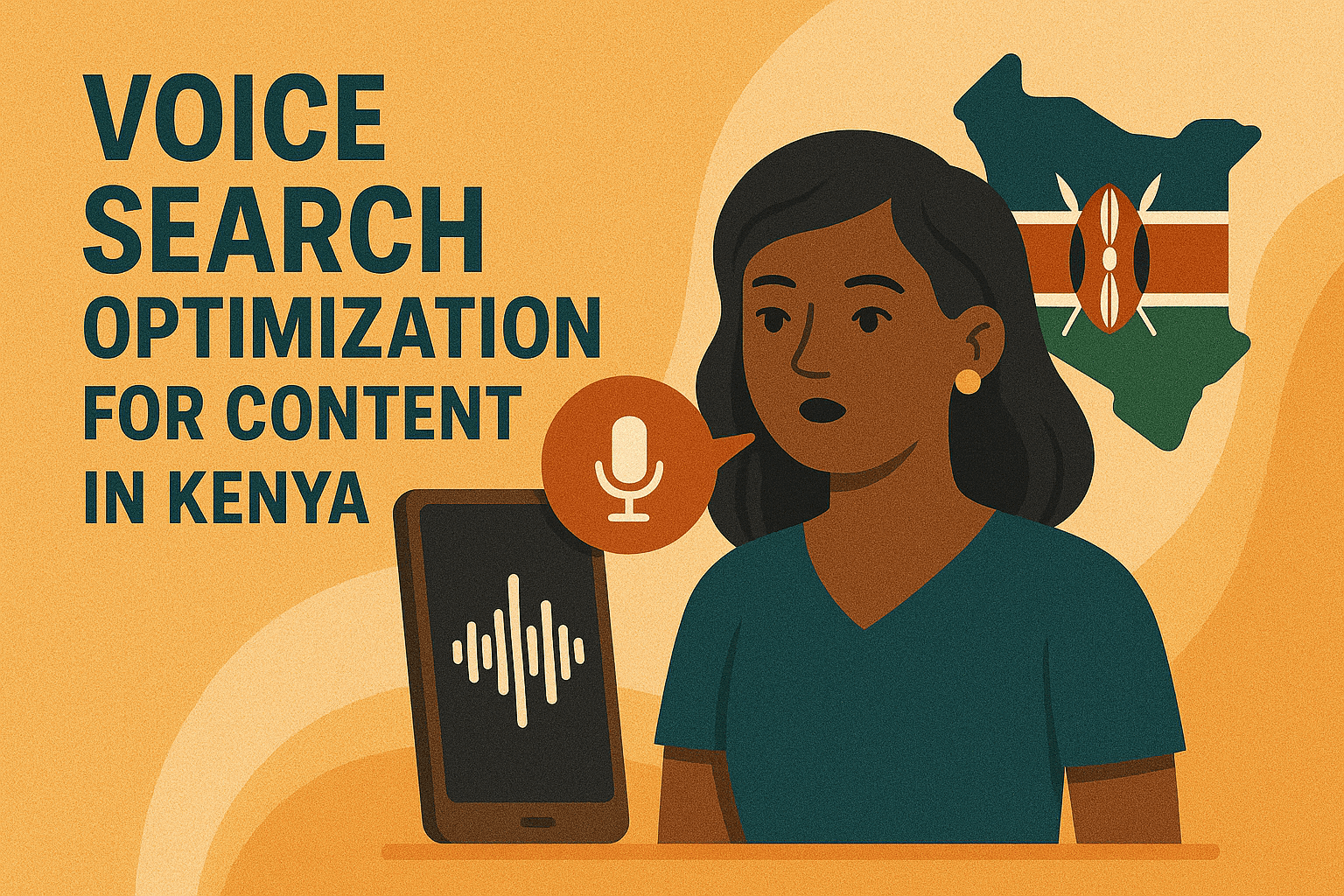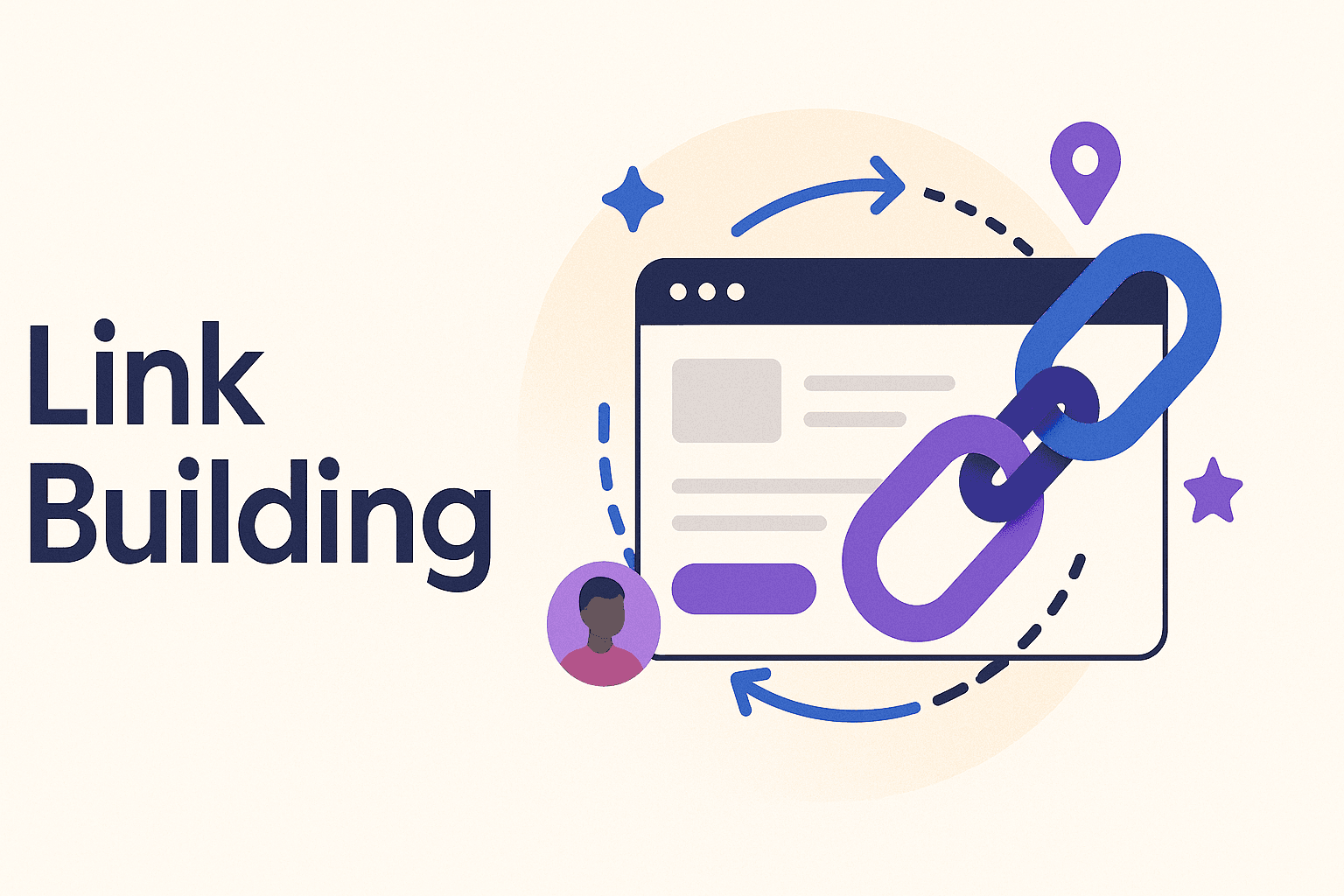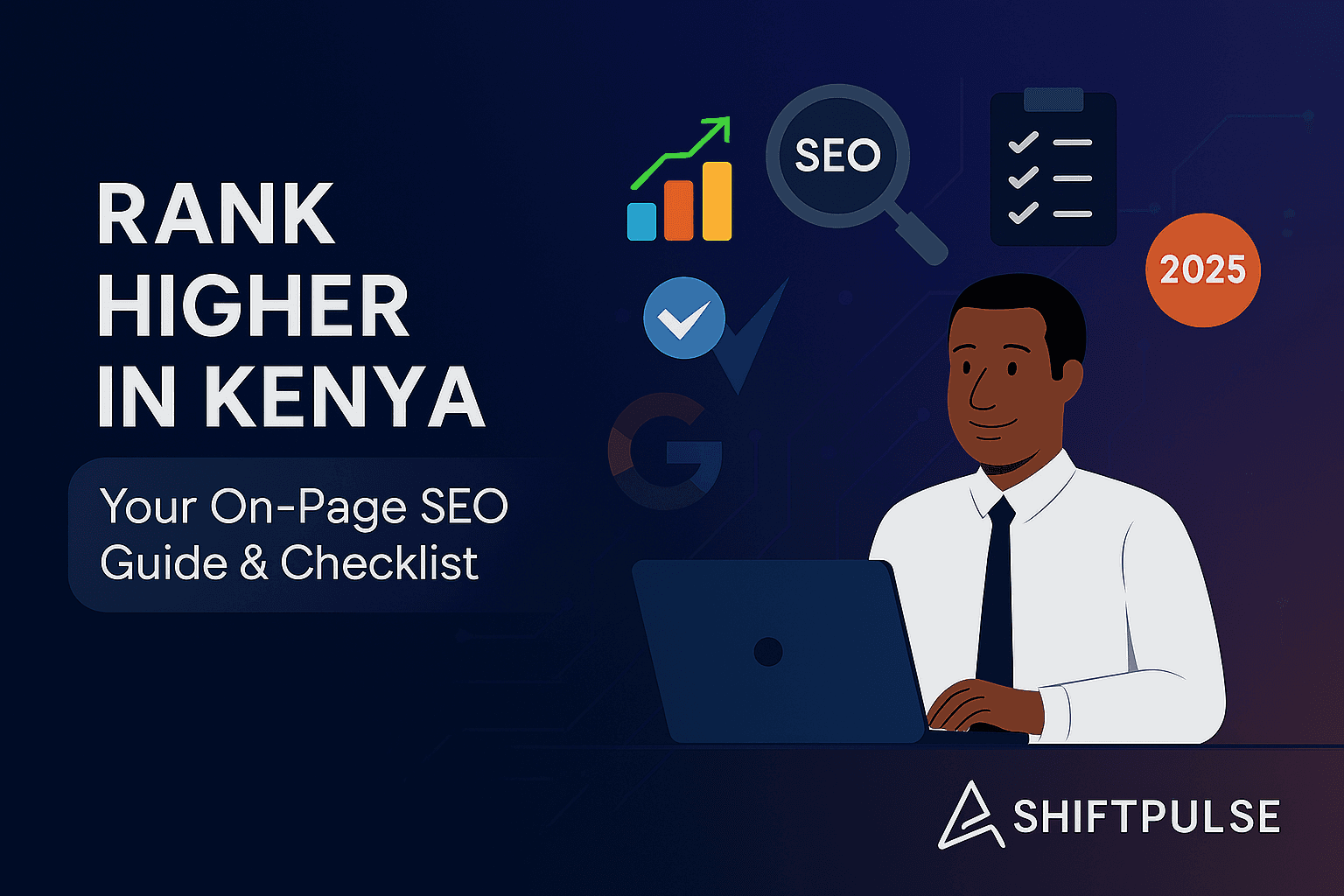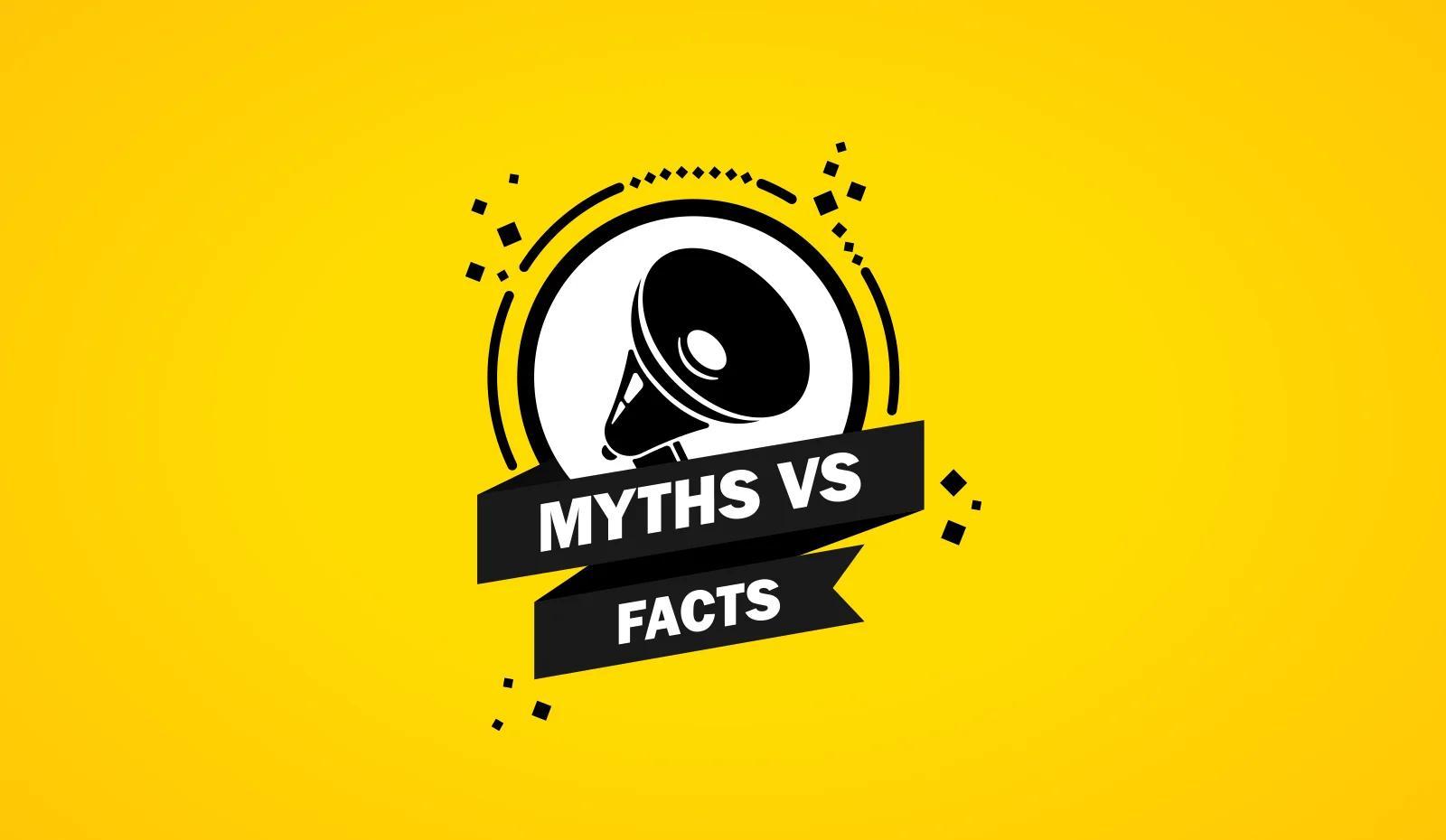
Carolyne Njunge
Shiftpulse Marketers
By Carolyne Njunge| Expert Digital Marketing Strategist at ShiftPulse (Published: April 12, 2025)
From Nairobi, Kenya, ShiftPulse specialises in developing advanced SEO and content strategies, including the pillar page/topic cluster model, tailored for businesses targeting the Kenyan market. We leverage deep market understanding and proven methodologies to build topical authority and drive sustainable online growth.

TL;DR: Building topical authority is crucial for Kenyan businesses in 2025, helping websites rank higher on Google.co.ke. The Pillar Page & Topic Cluster model structures content effectively, improving SEO and user engagement. ShiftPulse Digital helps brands implement this strategy to establish credibility and long-term search visibility.
By Carolyne Njunge| Expert Digital Marketing Strategist at ShiftPulse (Published: April 12, 2025)
From Nairobi, Kenya, ShiftPulse specialises in developing advanced SEO and content strategies, including the pillar page/topic cluster model, tailored for businesses targeting the Kenyan market. We leverage deep market understanding and proven methodologies to build topical authority and drive sustainable online growth.
Introduction: Why Topical Authority is Your Kenyan SEO Superpower in 2025
In Kenya's increasingly crowded digital space of 2025, simply publishing content isn't enough to guarantee visibility. With high internet penetration driven by mobile devices ¹ and fierce online competition ⁷, businesses need a smarter strategy to stand out on Google.co.ke. The key? Building Topical Authority.
Topical authority is Google's recognition that your website is a comprehensive, expert, and trustworthy resource on a specific subject ³⁷. Achieving it is crucial for ranking well, especially as search engines prioritize depth and expertise. But how do you systematically build this authority? At ShiftPulse, we leverage the proven Pillar Page and Topic Cluster model.
This isn't just an organizational tactic; it's a powerful SEO strategy that structures your content to perfectly align with how search engines understand information and how users seek knowledge ⁴⁰. Struggling to get traction for your core business topics in Kenyan search results? This ShiftPulse guide provides a comprehensive, step-by-step roadmap to implementing the pillar/cluster model effectively, tailored specifically for the nuances of the Kenyan market, giving you the "full help" needed for long-term SEO success.
The Pillar Page & Topic Cluster Model Explained (ShiftPulse Framework)
Think of this model as creating an incredibly organized and authoritative mini-library on your website for each core topic.
Pillar Page Defined
- What it is: A substantial, central webpage providing a comprehensive overview of a broad topic ³⁷, ⁵⁰. It acts as the main "hub."
- Content: Covers all key aspects of the topic broadly, linking out to more detailed resources ⁵⁰. Think "The Ultimate Guide to Digital Marketing in Kenya."
- Length: Typically long-form (can be 3,000-10,000+ words, depending on topic complexity ⁴⁵), focusing on breadth of coverage ⁵².
Topic Cluster Defined
- What it is: A group of interconnected articles or pages (cluster content), each diving deeply into a specific subtopic related to the main pillar theme ⁴⁰.
- Content: Provides specialized, detailed information on niche aspects introduced by the pillar ⁵². Examples related to the "Digital Marketing Kenya" pillar could include cluster pages on "SEO Keyword Research for Swahili," "Effective Facebook Ads for Kenyan SMEs," "Measuring Social Media ROI in Kenya."
- Size: A cluster might include 8-20+ supporting pages ⁵².
How it Works: The Hub-and-Spoke Structure
- Connections: The Pillar Page (Hub) links out to each Cluster Page (Spoke) ³⁷.
- Crucially: Each Cluster Page links back to the Pillar Page ⁴⁰.
- (Optional but Recommended): Related cluster pages can link to each other where it adds user value ⁴⁰.
(Visual Representation):
Code snippet
graph TD
A[Pillar Page: Digital Marketing Kenya] --> B(Cluster: SEO Keyword Research);
A --> C(Cluster: Facebook Ads Kenya);
A --> D(Cluster: Social Media ROI);
A --> E(Cluster: M-Pesa E-commerce Integration);
A --> F(Cluster: Influencer Marketing Kenya);
B --> A;
C --> A;
D --> A;
E --> A;
F --> A;
B --- C;
C --- F;
Why it Works (Search Engine Alignment)
- Semantic Understanding: This structure clearly shows Google the relationship between content pieces and the website's depth of knowledge on a topic ⁴⁰, ³⁸.
- User Intent Focus: It caters to users at different stages – those wanting a broad overview (pillar) and those needing specific answers (clusters).
- Authority Signals: The strong internal linking concentrates authority towards the pillar page and distributes it effectively throughout the cluster ⁴¹.
The SEO Advantage: Why Pillar/Clusters Win in Kenya (2025)
Implementing this model delivers significant SEO benefits specifically relevant to Kenyan businesses:
- Builds Strong Topical Authority & Trust: Systematically covering a topic demonstrates comprehensive expertise ³⁸, aligning perfectly with Google's E-E-A-T focus ³⁷. For Kenyan users seeking reliable information online ⁶⁸, this structured approach builds immense credibility ⁴¹.
- Creates Powerful Internal Linking: The inherent hub-and-spoke structure is SEO gold ³⁸. It boosts discoverability for crawlers, logically distributes PageRank/authority, and improves user navigation dramatically ⁴⁷, ³⁸.
- Enhances User Experience (UX) - Especially on Mobile: Provides clear pathways for users to find information ³⁸. Start broad (pillar), then dive deep (clusters). This easy navigation reduces bounce rates and increases time on site ³⁸ – critical factors for Kenya's predominantly mobile audience ¹.
- Boosts Google.co.ke Rankings: The combination of topical authority, strong linking, and better UX directly improves rankings ³⁸. You rank for broad pillar terms and numerous specific long-tail cluster keywords, capturing more relevant Kenyan search traffic ³⁸.
- Future-Proofs Your SEO: This strategy focuses on quality, depth, UX, and relevance – factors Google increasingly prioritizes ⁴¹. It's more resilient to algorithm updates than older tactics focused purely on isolated keywords ⁵⁶. ShiftPulse considers this a sustainable investment for long-term Kenyan SEO success.
Step 1: Choosing Your Core Pillar Topics for Kenya
This foundational step requires understanding your business and your specific Kenyan audience.
Researching Your Kenyan Audience (Needs & Pain Points)
- Methods ShiftPulse Uses:
- Analyze Existing Data: Customer demographics, purchase history, website analytics (Google Analytics) ⁸⁰.
- Direct Feedback: Surveys & interviews with Kenyan customers/prospects (uncovers pain points, language) ⁶⁷.
- Social Listening: Monitor Kenyan FB groups ³, Twitter (#KOT), TikTok trends ³ for conversations, questions, slang.
- Internal Feedback: Talk to your sales/customer service teams dealing directly with Kenyans ⁹³, ⁹².
- Persona Development: Create detailed buyer personas representing your ideal Kenyan customer segments (e.g., "Nairobi SME Owner," "Mombasa University Student," "Nakuru Farmer") ⁵².
- Focus: Identify the major problems your Kenyan audience faces that your business solves ⁵². What information are they actively seeking online related to your industry ⁶⁸? Understand their context (urban/rural, tech adoption, cultural values) ⁷.
Kenyan Keyword Research (Broad Topics)
- Goal: Find broad topic areas relevant to your business and your Kenyan audience, with decent search volume on google.co.ke but manageable competition ⁵². These become potential pillar pages.
- Tools: Use Google Keyword Planner ⁷, Google Trends (Kenya setting) ⁷, SEMrush ⁷, Ahrefs ⁷, Autosuggest ⁷ etc.
- Languages (CRITICAL for Kenya):
- Research in English (business/formal).
- Research in Swahili (national language, broad reach) ¹⁴³.
- Research relevant Sheng terms if targeting urban youth ¹⁴³ – use social listening, Google Suggest ⁷. ShiftPulse emphasizes authenticity here.
- Local Modifiers: Include "Kenya," cities ("Nairobi," "Mombasa"), or relevant regions ⁷.
- Volume vs. Difficulty: Balance search volume with your ability to realistically compete for rankings.
Kenyan Keyword Research Considerations for Pillar Topics
1. English
Recommended Tools:
- Google Keyword Planner (GKP)
- Google Trends
- SEMrush
- Ahrefs
- Autosuggest
- People Also Ask (PAA)
- Social Listening
Focus Areas:
- Competitor Analysis
- SERP (Search Engine Results Page) Analysis
- Search Intent Analysis
- Identifying High-Volume Keyword Potential
- Keyword Clustering
Kenyan Context Notes:
- Standard business and tech language is commonly used
- Very high competition for generic terms
- Requires strong domain authority to rank wel
2. Swahili
Recommended Tools:
- Google Keyword Planner (GKP)
- Google Trends
- SEMrush
- Ahrefs
- Autosuggest
- AnswerThePublic
Focus Areas:
- Use of local modifiers (e.g., “bei ya,” “jinsi ya”)
- Competitor Analysis focused on local sites
- Search Intent aligned with cultural context
- Caution with direct translations (ensure they are contextually relevant)
Kenyan Context Notes:
- Crucial for localization and reaching broader audiences
- Search behaviour varies significantly from English
- Often less competitive keywords
- Great opportunity for underserved search queries
3. Sheng
Recommended Tools:
- Google Trends
- Autosuggest
- Social Listening (TikTok, Twitter)
- Local Forums
Focus Areas:
- Trend Monitoring (Sheng evolves quickly)
- Deep audience research to understand slang and tone
- Monitor competitors if present in this space
Kenyan Context Notes:
- Targeted toward urban youth
- Language is fluid and highly dynamic
- Authenticity is key — avoid forced usage
- Standard SEO tools offer limited data, but engagement is often high
4. All Languages (General Approach)
Recommended Tools:
- Google Analytics
- Google Search Console
- SERP Feature Analysis (specific to google.co.ke)
Focus Areas:
- Mobile-First Optimization (majority of Kenyans browse via mobile)
- Voice Search Considerations
- Content Gap Analysis
- Audience Persona Alignment
- Local Modifiers and Question-Based Keyword Analysis
Kenyan Context Notes:
- Mobile usage dominates search behaviour
- Many local questions remain underserved
- Prioritize creating content that answers specific, local user needs
Analyzing Competitors in Kenya
- Identify: Find sites ranking well for your potential pillar keywords on google.co.ke ¹³⁰.
- Analyze: Study their content pillars, top pages/keywords, content types, site structure, backlink sources ¹³⁰, ¹⁴⁰, ⁹², ³³.
- Goal: Find their weaknesses, content gaps, or areas where you can provide superior, more locally relevant value ⁶⁷. Select pillar topics where you can realistically build authority.
Choosing the right pillar topics is critical. ShiftPulse offers in-depth market and keyword analysis to guide this decision.
Step 2: Mapping Your Topic Clusters
Break down your chosen pillar topic into specific subtopics for your cluster pages.
Identifying Subtopics (Cluster Keywords)
- Source Ideas: Use keyword research tools (look for related terms, questions via AnswerThePublic ⁷, PAA ³⁹), long-tail variations ⁷.
- Focus: Each cluster page should address a specific aspect of the main pillar topic ⁵⁰.
- Keyword Clustering: Group semantically related keywords using tools (like SEMrush's tool ⁹⁶) or by analyzing SERP overlap ¹⁸⁷ to ensure each cluster page has a tight focus ⁵⁰.
Understanding Search Intent for Kenyans (Crucial for Clusters)
- Revisit Intent Types: Informational, Navigational, Commercial, Transactional ⁴¹, ¹¹⁶.
- Analyze Each Cluster Keyword: What is the primary goal of a Kenyan searching for this specific subtopic? Use SERP analysis on google.co.ke ¹³⁸.
- Match Content Format: Align the cluster page type (blog post, product page, guide) to the dominant intent revealed by the SERP ⁹⁶.
Keyword Modifiers and Search Intent (with Kenyan Examples)
1. Informational Intent
Common Modifiers:
- how to, what is, why, guide, tips, learn
- Swahili equivalents: jinsi ya, nini
Kenyan Examples:
- “jinsi ya kupika pilau kitamu” (how to cook delicious pilau)
- “what is NHIF Kenya”
- “faida za kilimo hai” (benefits of organic farming)
2. Navigational Intent
Common Modifiers:
- [brand name], login, contact, portal, [product/service name]
Kenyan Examples:
- “Safaricom home fiber packages”
- “KRA iTax portal login”
- “Java House menu”
3. Commercial Investigation Intent
Common Modifiers:
- best, top, review, compare, vs, affordable, deals, bei
Kenyan Examples:
- “best Saccos for dividends Kenya”
- “Samsung vs Tecno camera comparison”
- “affordable web hosting Nairobi”
- “bei nafuu za laptops” (affordable laptop prices)
4. Transactional Intent
Common Modifiers:
- buy, order, price, discount, near me, book
- Swahili equivalents: nunua, agiza
Kenyan Examples:
- “buy mabati online Kenya”
- “Mpesa paybill charges”
- “book flight Nairobi Mombasa”
- “fundi wa gari Westlands” (mechanic Westlands)
Mapping Content to the Kenyan Buyer Journey
Structure your cluster content to guide users:
- Awareness: Informational content answering basic questions (e.g., "What is Forex Trading in Kenya?") ⁴¹.
- Consideration: Content comparing solutions or diving deeper (e.g., "Comparing Forex Brokers Available to Kenyans," "Risks of Forex Trading") ⁴¹. Matches commercial intent.
- Decision: Content facilitating action (e.g., "How to Open a Forex Account in Kenya," specific broker review page with sign-up link) ⁴¹. Matches transactional intent.
- Kenyan Context: Address local concerns at each stage (payment methods ²¹⁰, regulations, local support availability ⁷¹).
Step 3: Crafting High-Impact Kenyan Pillar Pages
This is your authoritative hub. Make it exceptional.
Content Structure & Navigation
- Logical Flow: Use clear H1, H2, H3 hierarchy ³³. Structure the broad topic logically.
- Table of Contents (ToC): Essential for long pages. Use clickable links ⁶³. Improves UX significantly on mobile.
- Visual Breaks: Use relevant, optimized images, infographics, charts, embedded videos ³³. Use Kenyan context visuals where possible ¹⁰⁶.
- Scannability: Short paragraphs, bullet points, bold text for key takeaways ⁷⁸. Critical for mobile Kenya.
Content Depth & Quality
- Comprehensive Overview: Cover all key subtopics related to the pillar theme ³⁷.
- High Quality: Accurate, well-researched, informative, engaging ¹⁵. Establish credibility.
- Evergreen (Mostly): Aim for lasting relevance, but schedule regular updates for accuracy ⁴³.
- Link Out Strategically: Link contextually to all relevant cluster pages for deep dives ⁵⁰.
Internal Linking (Pillar -> Cluster)
- Essential: Link from the relevant section of the pillar page to each supporting cluster page ³⁸.
- Descriptive Anchor Text: Use anchor text that clearly describes the cluster page's topic, often including its target keyword ³⁸.
On-Page SEO Optimization (Kenyan Focus)
Apply best practices meticulously (see Table 3).
Pillar Page On-Page SEO Checklist (Kenyan Context)
Title Tag
- Best Practice: Under 60 characters, primary keyword near the start, compelling.
- Kenyan Consideration: Include “Kenya” if relevant. Use Swahili/Sheng if it’s the primary keyword for the entire pillar.
Meta Description
- Best Practice: Under 160 characters, includes keyword, value proposition, and encourages clicks.
- Kenyan Consideration: Mention relevance to the Kenyan audience or market.
H1 Tag
- Best Practice: Only one per page, clearly reflects the main topic and primary keyword.
- Kenyan Consideration: Match keyword research, including language preference (Kenyan English, Swahili, etc.).
Subheadings (H2/H3)
- Best Practice: Use a logical hierarchy, incorporate keywords naturally.
- Kenyan Consideration: Structure for easy mobile scanning. Use Swahili/Sheng only if it fits naturally and suits the audience.
Body Content
- Best Practice: Comprehensive, high-quality writing with natural keyword use (avoid stuffing).
- Kenyan Consideration: Include local examples, context, Kenyan statistics/data. Mix appropriate language (Kenyan English, Swahili).
Image Alt Text
- Best Practice: Descriptive, includes keywords, explains image context.
- Kenyan Consideration: Add location if relevant (e.g., “digital marketing agency Nairobi”).
URL Structure
- Best Practice: Short, descriptive, keyword-rich, use hyphens.
- Kenyan Consideration: Example: /digital-marketing-strategies-kenya.
Internal Links
- Best Practice: Link to all related/cluster pages using descriptive anchor text.
- Kenyan Consideration: Ensure links are clearly visible and tappable on mobile devices.
Mobile Optimization
- Best Practice: Responsive design, legible fonts, tappable elements.
- Kenyan Consideration: Critical due to high mobile usage in Kenya—test thoroughly.
Load Speed
- Best Practice: Optimize images, code, and hosting to load under 3 seconds.
- Kenyan Consideration: Vital due to varying network speeds and data costs in Kenya.
Table of Contents (ToC)
- Best Practice: Include a clickable ToC near the top for longer content.
- Kenyan Consideration: Enhances mobile usability—especially important for long articles.
Step 4: Developing Effective Kenyan Cluster Content
These pages provide the depth and target specific queries.
Focus, Depth & Local Relevance
- Niche Down: Each page targets ONE specific subtopic or long-tail keyword ³⁸, ⁴⁰.
- Be the Expert: Provide comprehensive, detailed information on that specific query. Aim to be the best resource ⁴⁰.
- Hyper-Localize: This is where Kenyan context shines!
- Use specific Kenyan examples, data, local case studies ¹⁰⁵.
- Address needs/regulations pertinent to Kenya (e.g., M-Pesa integration ²¹⁰, DPA compliance ²⁴⁵).
- Use Swahili/Sheng naturally if keywords and audience warrant it ⁷.
Linking Back to Pillar
- Mandatory: Every cluster page must link back to the main pillar page ³⁸.
- Anchor Text: Use consistent, relevant anchor text, often the pillar's primary keyword ⁵².
Optimizing for Long-Tail Keywords
- Target Precisely: Cluster pages are perfect for ranking for specific, high-intent long-tail searches common in Kenya ⁷, ¹⁰⁶.
- On-Page SEO: Apply rigorous on-page optimization (title, meta, headings, etc.) focused on the cluster page's specific long-tail keyword ³³.
Cluster Content Best Practices Checklist (Kenyan Focus)
In-depth on Subtopic
- Why It Matters for Kenya: Satisfies specific Kenyan queries and builds niche authority.
- Implementation Tip: Be the most comprehensive resource in Kenya for that exact subtopic or keyword.
Link Back to Pillar
- Why It Matters for Kenya: Reinforces cluster structure for google.co.ke and passes SEO authority.
- Implementation Tip: Include at least one clear, contextual link back to the pillar page using the pillar’s primary keyword as the anchor text.
Use Local Examples/Data
- Why It Matters for Kenya: Increases relevance, relatability, and trust for Kenyan audiences.
- Implementation Tip: Cite Kenyan statistics, reference local brands/events, and use Kenyan-based scenarios.
Use Local Language
- Why It Matters for Kenya: Connects authentically if the keyword or audience naturally uses Swahili or Sheng.
- Implementation Tip: Weave Swahili/Sheng terms naturally where they fit. Define the term if it’s not universally understood.
Target Long-Tail Keywords (LTK)
- Why It Matters for Kenya: Captures specific, high-intent searches that often have less competition.
- Implementation Tip: Optimize the entire page (title, H1, meta, content) around the long-tail keyword (e.g., “how to register sole proprietorship Kenya”).
On-Page SEO for Long-Tail Keywords
- Why It Matters for Kenya: Ensures visibility for specific cluster topics on google.co.ke.
- Implementation Tip: Apply all standard on-page SEO best practices (title, headers, alt text, etc.) optimized for that long-tail keyword.
Address Kenyan Context
- Why It Matters for Kenya: Solves specific local problems and aligns with Kenyan regulations and culture.
- Implementation Tip: Tailor advice with local specifics like M-Pesa, Kenyan Data Protection Act (DPA), infrastructure, and cultural considerations.
Mobile-First Content
- Why It Matters for Kenya: Most Kenyans browse on mobile—performance here is critical.
- Implementation Tip: Use short paragraphs, bullets, responsive design, fast-loading media, and white space for readability.
Step 5: Implementing Strategic Internal Linking
The links are the pathways defining your authority.
Why Internal Linking is Critical Here
- Shows Relationships: Explicitly maps content hierarchy for Google ³⁸.
- Distributes Authority: Passes "link juice" effectively through the cluster ³⁸.
- Improves User Navigation: Allows seamless exploration from broad to specific topics ³⁸. Vital for Kenyan mobile users.
- Boosts Crawlability/Indexing: Guides search bots efficiently, ensuring all content gets found ⁴⁷, especially important in Kenya.
How to Implement (The ShiftPulse Method)
- Pillar -> All Clusters: Link contextually from pillar sections to relevant cluster pages ³⁸. Use descriptive anchor text ³⁸.
- All Clusters -> Pillar: Every cluster page links back to the main pillar page ³⁸ using consistent anchor text (pillar's main keyword) ⁵².
- Cluster <-> Cluster (Optional but Recommended): Link between related cluster pages only where it adds genuine user value ⁴⁰, ⁵⁹. Don't force it.
- Contextual Placement: Place links naturally within the body content where they make sense ⁵⁹.
Step 6: Your Kenyan Pillar/Cluster Implementation Checklist
Use this to guide your process:
Pillar/Cluster Implementation Checklist for Kenyan Websites
Phase 1: Planning
- Define Target Kenyan Audience (Personas) Local data, social listening (Facebook, YouTube, TikTok, WhatsApp), surveys. Mobile-first insights.
- Brainstorm Pillar Topics (Solving Kenyan Needs) Focus on local pain points and national trends.
- Kenyan Keyword Research (Pillar – English, Swahili, Sheng?) Use Google Keyword Planner, Trends, SEMrush, Autosuggest. Add local modifiers (e.g., Nairobi, M-Pesa).
- Analyze Competitors (google.co.ke) Use SEMrush, Ahrefs. Identify content gaps that are relevant to Kenya.
- Select Final Pillar Topic (Broad, Relevant, Achievable) Consider local search volume, competition, and national relevance.
Phase 2: Cluster Development
- Deeper Keyword Research (Subtopics – Long-tail, Questions – Multilingual) Tools: AnswerThePublic, PAA, SEMrush. Prioritize specific Kenyan queries.
- Group Keywords into Clusters Use keyword clustering tools or manual SERP analysis.
- Map Subtopics to Intent & Kenyan Buyer Journey Use content mapping frameworks tailored to Kenyan user behavior.
- Audit Existing Content Identify pieces that can be repurposed or expanded into clusters.
- Plan New Cluster Content Prioritize based on potential value and keyword opportunity.
Phase 3: Pillar Page Creation
- Create Comprehensive Pillar Page Content(In Progress) Ensure quality, depth, and strong structure (include Table of Contents).
- Optimize Pillar On-Page SEO(In Progress) Focus on primary keyword, mobile responsiveness, and fast load speed.
Phase 4: Cluster Page Creation
- Create In-Depth Cluster Page Content(In Progress) Each page should address a specific subtopic or long-tail keyword.
- Incorporate Local Kenyan Relevance(In Progress) Use Kenyan examples, stats, brands, and natural Swahili/Sheng where applicable.
- Optimize Cluster On-Page SEO(In Progress) Focus each page on its unique long-tail keyword.
Phase 5: Linking & Launch
- Link: Pillar → All Cluster Pages(In Progress) Use clear, descriptive anchor text for user clarity.
- Link: All Clusters → Pillar Page(In Progress) Use consistent anchor text using the pillar’s primary keyword.
- Link: Relevant Clusters ↔ Clusters(In Progress) Only interlink where it adds contextual or topical value.
- Publish Pillar & Cluster Pages Ensure final checks for SEO, load speed, and mobile-friendliness.
Phase 6: Monitoring & Optimization
- Track Rankings (Pillar & Cluster Keywords on google.co.ke)(Ongoing) Use SEMrush, Ahrefs, Google Search Console.
- Monitor Traffic & Engagement (Pillar & Clusters)(Ongoing) Google Analytics – check traffic sources, bounce rate, session time.
- Analyze Performance & Identify Improvements(Ongoing) Evaluate which clusters perform best. Improve underperformers.
- Regularly Update/Refresh Content(Ongoing) Keep information up-to-date with Kenyan trends and data.
Conclusion: Build Lasting Authority – Your Next Steps with ShiftPulse
The pillar page and topic cluster model isn't just an SEO tactic; it's a strategic investment in building lasting topical authority and providing exceptional value to your Kenyan audience. By structuring your content logically and comprehensively covering topics relevant to Kenya, you signal expertise to Google and become a trusted resource for users ³⁸.
This isn't a quick fix. It requires consistent effort, deep audience understanding, meticulous research (including local language nuances), quality content creation, and ongoing analysis ⁴¹. But the rewards – sustainable high rankings on google.co.ke, qualified organic traffic, enhanced brand credibility, and resilience against algorithm updates – are substantial for Kenyan businesses committed to long-term digital success.
ShiftPulse specialises in architecting and implementing these powerful content strategies for the Kenyan market. We help businesses identify the right topics, create high-impact pillar and cluster content, and build the authority needed to dominate their niche online.
Ready to build dominant topical authority and achieve sustainable SEO growth in Kenya?
Contact ShiftPulse today for an expert SEO and Content Strategy consultation.



















